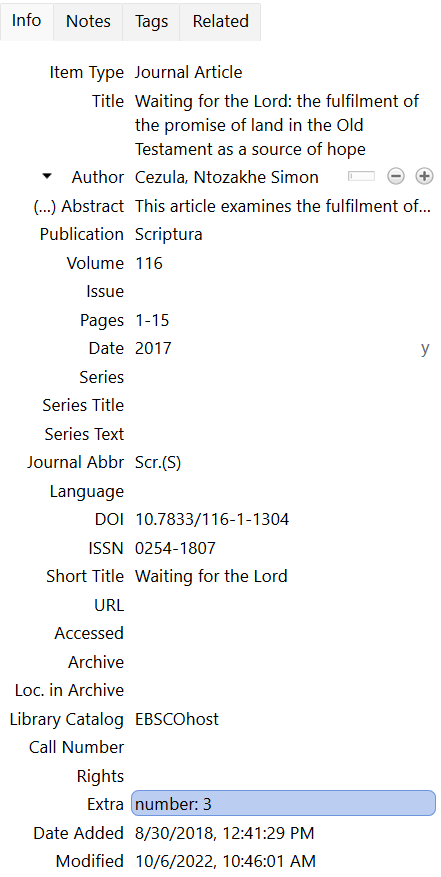Several good online journals that publish articles electronically only.1 And sometimes such journals paginate their articles separately from each other (i.e., each numbering their first page as “1”), rather than running the pagination continuously through a given issue (or volume).
What SBL Style Requires
A couple examples are HTS Teologiese Studies and Scriptura (at least in recent volumes). And SBL Press has clarified that their preferred way to have these kinds of articles cited is as follows
[Author name], “[Title],” [Journal] [Journal volume] ([Journal volume year]): art. [Article number in the journal volume], [“p.” or “pp.” according to whether one or multiple pages is cited] [Page number], [Full DOI URL as a live link].2
The bibliography format then makes the usual changes for a journal article and includes “pp.” with the total page range for the article. Thus, one example of an initial footnote would be
1. Ntozakhe Simon Cezula, “Waiting for the Lord: The Fulfilment of the Promise of Land in the Old Testament as a Source of Hope,” Scr.(S) 116 (2017): art. 3, p. 13, http://dx.doi.org/10.7833/116-1-1304.
Subsequent references are constructed in the same way as they would be for any other journal article. Thus, you would have
3. Cezula, “Waiting for the Lord,” 10–11.
And the corresponding bibliography entry would be
Cezula, Ntozakhe Simon. “Waiting for the Lord: The Fulfilment of the Promise of Land in the Old Testament as a Source of Hope.” Scr.(S) 116 (2017): art. 3, pp. 1–15. http://dx.doi.org/10.7833/116-1-1304.
An Open Question about What SBL Style Requires
In the process of reviewing how best to accommodate this citation pattern with software like Zotero, Denis Maier noted some inconsistency between SBL Press’s two posts on the topic.3
In particular, SBL Press’s discussion of HTS
- gives “doi: ” rather than “https://doi.org/” and
- omits the full page range from its sample bibliography entry for Christo Lombaard’s essay on theological education.4
I’ve posted a comment to SBL Press on their HTS post to ask for clarification about the page range omission in the bibliography. But in the meantime, there are three reasons it seems best to with the citation pattern described in the more general “Electronic Journals” post—namely, that this post
- Is more general than the HTS-specific post and describes a pattern of citation for sources that would include HTS and others.
- Appeared after the HTS-specific post (3 May 2018 versus 9 August 2016). It, therefore, represents more current guidance about the press’s style. This situation then becomes similar to the relationship that the SBL Handbook of Style blog overall has toward the SBL Handbook of Style itself.
- Explicitly says that “to bring SBLHS into greater conformity with CMS in the formatting of DOIs, SBL Press now prefers including the full URL (i.e., with https://), not just the DOI proper.”5
This last comment explicitly settles the DOI format issue question over against the recommendation of the HTS-specific post. This explicit relationship between the two posts on this issue suggests that it’s most likely they have the same relationship, albeit implicitly, on the issue of whether or not to include a full article page range in the bibliography entry. But that question does remain somewhat open pending the press’s further confirmation.
How to Get What SBL Style Requires
Assuming that this is a proper reading of what SBL style requires for individually paginated electronic journal articles, this citation format has some notable oddities and departures from what’s otherwise typical for journal articles.
Even so, Zotero can still produce the correct citation format if you have the current version of the SBL style (2nd ed.) installed from the repository. And once you have the style installed from there, you’ll automatically get future updates as they become available.
(If you haven’t already installed the style from the repository, click here to drop in your email. And I’ll send you the direct link to the repository’s entry for this style, along with several others you might find useful.)

When you come to correcting the Zotero record for this kind of article, the key point is to drop the number variable in the Extra field along with the article’s placement in the sequence of its issue or volume. Everything else, you’d enter as you usually would, being careful to include the DOI (or, if that’s not available, a URL) since you’re dealing with a specifically electronic source.6
So, for instance, if the article you’re citing is the third in its sequence, you’d enter into the Extra field number: 3. That variable will allow the SBL style for Zotero to trigger the proper citation format for your article.
You can also use the same process to set Zotero up to cite articles that aren’t segmented by pages. For example, articles from early issues of TC were released and are still only available as webpages.
With these articles, however, you’d obviously need to leave blank the “Pages” field in your Zotero record. But you can choose the paragraph locator type in the citation dialog to get ¶ or ¶¶ as appropriate. Thus, you might have
1. Richard D. Weis, “Biblia Hebraica Quinta and the Making of Critical Editions of the Hebrew Bible,” TC 7 (2002): art. 6, ¶45, http://jbtc.org/v07/Weis2002.html.
3. Weis, “Critical Editions,” ¶¶37–40.
And in your bibliography, you would have
Weis, Richard D. “Biblia Hebraica Quinta and the Making of Critical Editions of the Hebrew Bible.” TC 7 (2002): art. 6, n.p. http://jbtc.org/v07/Weis2002.html.
Conclusion
SBL style is reasonably complex anyway. And it involves still more variation if you’re using individually paginated articles from electronic journals. But even in this case, Zotero can handle the citation work and, by taking that of your plate, free you up to focus on writing new material.
Header image provided by Pereanu Sebastian. ↩
SBL Press, “Electronic Journals with Individually Paginated Articles,” weblog, SBL Handbook of Style, 3 May 2018. ↩
“Update Society-of-Biblical-Literature-Fullnote-Bibliography.Csl by Dstark · Pull Request #6157 · Citation-Style-Language/Styles,” GitHub, n.d. ↩
SBL Press, “HTS Teologiese Studies/Theological Studies,” weblog, SBL Handbook of Style, 9 August 2016. ↩
SBL Press, “Electronic Journals.” ↩
Thanks are due to Brenton Wiernik for this idea. ↩

Leave a Reply